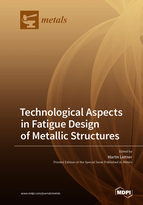Technological Aspects in Fatigue Design of Metallic Structures
A special issue of Metals (ISSN 2075-4701). This special issue belongs to the section "Metal Failure Analysis".
Deadline for manuscript submissions: closed (31 December 2021) | Viewed by 25607
Special Issue Editor
Interests: fatigue design; technological aspects; high- and low-cycle fatigue assessment; structural durability; fracture behavior
Special Issues, Collections and Topics in MDPI journals
Special Issue Information
Dear Colleagues,
Traditional manufacturing processes like casting and welding and modern techniques like additive manufacturing can significantly affect the local material properties of metallic materials. To ensure a safe and reliable operation of engineering components and structures, the knowledge of manufacturing effects on the fatigue performance is of utmost importance. Hence, this Special Issue focuses on the fatigue design of metallic structures considering the influence of technological aspects. Approaches based on local stress or strain as well as fracture-mechanics-based concepts are applicable, considering local manufacturing-process-dependent characteristics such as microstructure, hardness, porosity/defects, surface topography, or residual stress state. Furthermore, advanced methods utilizing the notch stress intensity factor (NSIF) or strain energy density as well as probabilistic approaches are feasible to properly assess the local fatigue strength or life. Research articles and reviews emphasizing technological aspects in the fatigue design of metallic structures incorporating experimental and/or numerical investigations are welcome.
Prof. Dr. Martin Leitner
Guest Editor
Manuscript Submission Information
Manuscripts should be submitted online at www.mdpi.com by registering and logging in to this website. Once you are registered, click here to go to the submission form. Manuscripts can be submitted until the deadline. All submissions that pass pre-check are peer-reviewed. Accepted papers will be published continuously in the journal (as soon as accepted) and will be listed together on the special issue website. Research articles, review articles as well as short communications are invited. For planned papers, a title and short abstract (about 100 words) can be sent to the Editorial Office for announcement on this website.
Submitted manuscripts should not have been published previously, nor be under consideration for publication elsewhere (except conference proceedings papers). All manuscripts are thoroughly refereed through a single-blind peer-review process. A guide for authors and other relevant information for submission of manuscripts is available on the Instructions for Authors page. Metals is an international peer-reviewed open access monthly journal published by MDPI.
Please visit the Instructions for Authors page before submitting a manuscript. The Article Processing Charge (APC) for publication in this open access journal is 2600 CHF (Swiss Francs). Submitted papers should be well formatted and use good English. Authors may use MDPI's English editing service prior to publication or during author revisions.
Keywords
- Fatigue design
- Technological aspects
- Metallic structures
- Manufacturing processes
- Material properties
- Local stress/strain approaches
- Fracture mechanics
- Advanced fatigue methods






